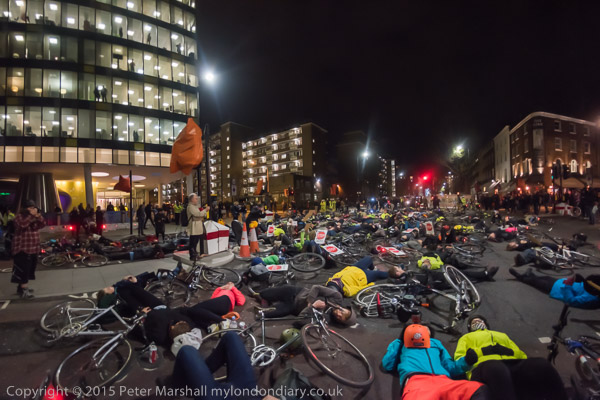
It was on my sixth birthday that I got my first two-wheeler. Before that I’d had a pedal car and then a basic trike, both of which I rode along the pavements of our street, and just occasionally on the road. There wasn’t a lot of traffic then. It wasn’t a main road, a side road in what is now one of London’s outer boroughs, then a part of Middlesex. On the stretch of a few hundred yards on which we played, there were a handful of shops and perhaps 50 houses. Usually only one car was ever parked there, owned by the parents of one of my boyhood friends, often playing around our house or on the street. He and his parents lived in his gran’s small house; they could afford a car because both his parents went out to work – something my mother definitely didn’t approve of. A few years later they moved out to a council flat a couple of miles away. Times have very much changed.
Of course it wasn’t a new bike. Like the trikes and the pedal car it had been handed down. It wouldn’t have been new when my elder brothers had ridden it, but probably my father had cleaned it up and given it a new coat of paint, keeping it hidden in a corner of his workshop so it came as a surprise.
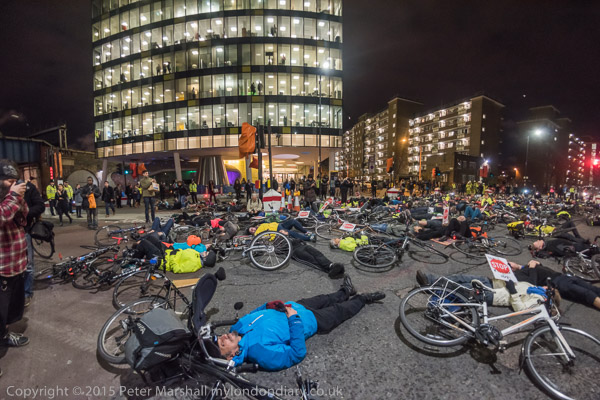
For a few hours I was on it, riding up and down the pavement with an older brother’s hand on the saddle running with me, until eventually I realised I was on my own and had travelled a few yards before putting my feet down. Then I had it, and could ride, and after a little more practice could both start off and stop without falling off. It was freedom.
It wasn’t long before I was riding to visit friends from my class who lived half a mile away, and when they too got bikes we would ride around the local heath, and to parks and woods to play. And to get chased by park keepers, as cycling there certainly was not allowed.
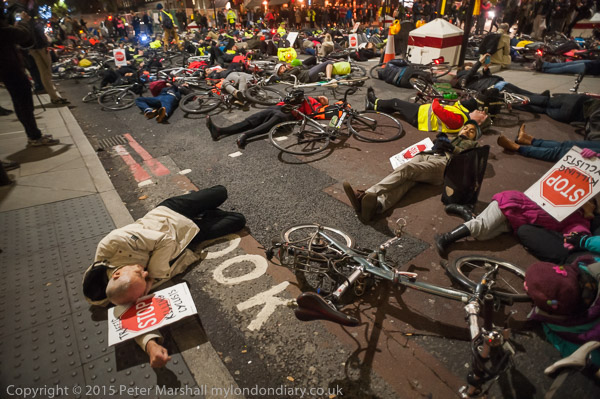
Event organiser Donnachadh McCarthy (left) taking part in the die-in
A couple of years later I graduated to a larger model – again ten or twelth-hand – but with hub gears, and there was no holding us back. Soon we were cycling out to Box Hill or Virginia Water and other places around the south-west edges of London, often making our way along major roads such as the A3, A4, A30. A few sections built in the 1930s had cycle paths, but most didn’t, and we made our way in often heavy traffic.
Even so, it was safer than today. Traffic speeds on the open road were generally slower and lorries were smaller. Now my parents would probably have their children taken away by social services if they allowed them the freedom we enjoyed. But then they made sure we knew the rules of the road, taught us to keep our bikes in good order and left us to it.
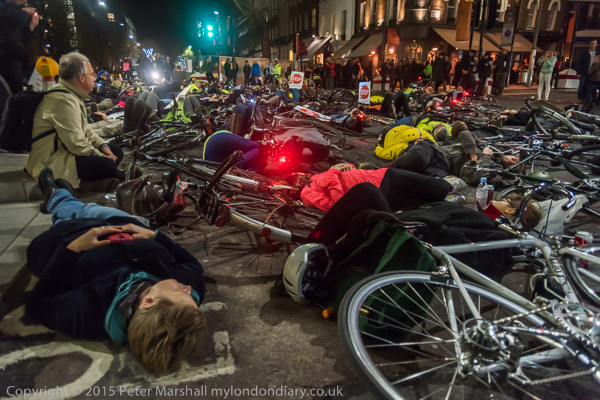
Many reasons have combined to make our roads now less safe for cyclists – and some of the changes have been deliberate. Traffic engineering for many years only considered how to allow cars and lorries go faster, realigning junctions, roundabouts and one way systems, designing them with this in mind. It’s still happening with many local authority transport departments, increasing the danger to cyclists and pedestrians at many junctions.
In recent years, things have begun to change. Cycling in London got a boost from the 2005 bombings, which made some people reluctant to use the tube, and numbers of cyclists continue to increase. Folding bikes like the Brompton I sometimes now use have increased many people’s choices, making bikes easy to store in small flats or at the office and allowing commuters to combine cycling with tube or rail. And those misnamed ‘Boris Bikes’ that Ken set in motion have encouraged many more to get on a bike.
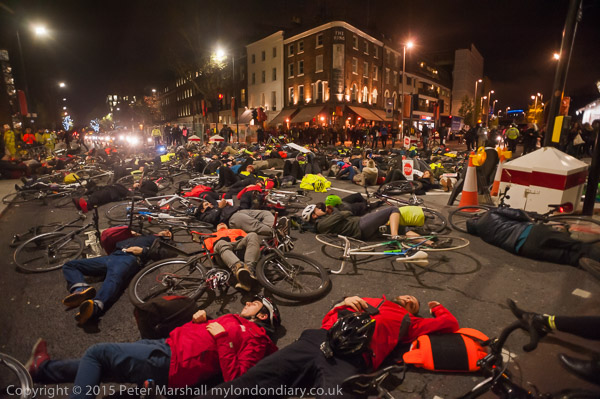
Safety is a major reason many people give for not cycling in London, and there is good reason behind this. At last November’s protest there was a row of 21 mock coffins, one for each of the cyclists killed on London’s roads in the previous 2 years. The great majority of them killed by heavy goods vehicles, particularly skip lorries, designed with very limited vision to the rear and along their sides.
The protest was organised by ‘Stop Killing Cyclists’, a pressure group calling for a much greater emphasis on cycle safety. In Stop Killing Cyclists Die-in you can see and outline of the list of demands for safer cycling they presented to London’s then prospective Mayoral candidates. The response from Sadiq Khan, now elected to the post was not too encouraging (though a little more positive than than of his main rival, the allegedly green Conservative Zac Goldsmith, both probably deciding that there were few votes for cyclists and promising more might upset motorists) but we can expect to see some progress under his reign. And outgoing mayor Boris’s last official engagement was to open the latest part of a cycle superhighway, a segregated bike path across Blackfriars Bridge.
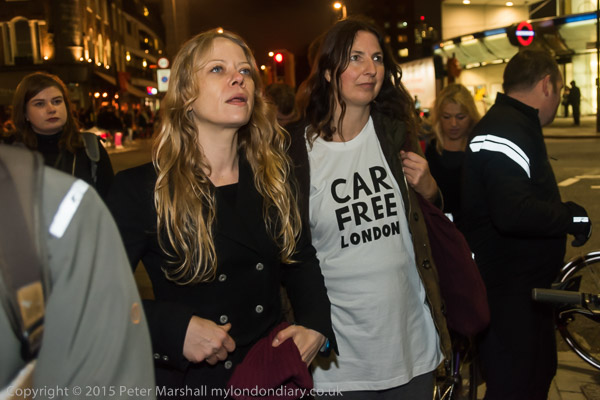
Green Party Mayoral candidate Sian Berry (centre left) at the protest
Photographing the cyclists’ die-in just a quarter of a mile down the Blackfriars Rd from that bridge Bridge in front of the Transport for London offices presented some problems. Of course there wasn’t a great deal of light almost two hour after sunset, but it was more a matter of both giving an idea of the sheer number of bikes involved and of also of getting some strong foreground interest – and of avoiding other photographers, a few of whom were something of a nuisance wandering into the centre of the die-in.
I made use of the 16mm fisheye, as well as the 20mm f2.8 and the 28.0-200 mm to try and make effective images, and felt I’d done a reasonable job. There are examples from each of these lenses above (the fisheye images converted using FisheyeHemi as usual.) Of course I photographed other things than the die-in and Sian Berry, though you will find more pictures of both as well as more about the event at Stop Killing Cyclists Die-in.
______________________________________________________
There are no adverts on this site and it receives no sponsorship, and I like to keep it that way. But it does take a considerable amount of my time and thought, and if you enjoy reading it, the occasional small donation – perhaps the cost of a beer – would be appreciated.
My London Diary : Buildings of London : River Lea/Lee Valley : London’s Industrial Heritage
All photographs on this and my other sites, unless otherwise stated, are taken by and copyright of Peter Marshall, and are available for reproduction or can be bought as prints.
To order prints or reproduce images
________________________________________________________